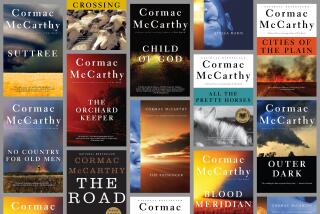6 things you should know about ‘The City of Mirrors’
- Share via
1. It’s huge.
“The City of Mirrors” debuted at the top of our Bestseller list earlier this month. The book is the conclusion to Justin Cronin’s bestselling dystopian literary trilogy, which started with “The Passage” (great) followed by “The Twelve” (not as great).
2. It’s binge-worthy.
With a total of 2,000 pages, the easiest way to engage with this story of the scrappy survivors of a viral vampire plague may be to binge-read all three books in sequence, so you can keep track of who is who, how far they’ve traveled, and what is happening.
3. Familiar characters return.
The main characters, many of whom started out as children in a forgotten waystation in the mountains near Palm Springs when waves of devastation originally depopulated North America, are now middle-aged parents, even grandparents. Sara is a doctor; Michael is rebuilding a ship that, he hopes, will take them away from the continent; Peter Jaxon is the president of the stable and safe (but not for long) community they’ve made in Texas. Amy, who is still central to the story, is hidden away where probing vampire thoughts can’t reach her.
4. Patient Zero is kind of boring.
We know that the vampire hordes have psychic leaders, and while many were defeated in “The Twelve,” Zero (as in Patient Zero) remains. His backstory, which is almost long enough to be a novel on its own, reads like a failed one that should have been shelved. There’s nothing special about this Midwesterner feeling like an outcast at his Ivy League college or his unrequited love for his best friend’s girl. For a creature bent on mankind’s extinction, in a series with so much violence and vigor, you’d think the origin story would have a little more umph.
5. It’s got great fight scenes.
Finally, when the book reaches its midpoint, the threat to humans re-emerges. As in the first two books, the vicious transformed vampires are terrifying: fast-moving, super-strong, insatiable. Accustomed to decades of quietude, people are sitting ducks as the night begins to fill with the monsters that can kill or contaminate in a heartbeat. The battles with the clearly outmatched humans are frightening and thrilling.
6. Do not read the epilogue.
Set 1,000 years after the viral vampires nearly wiped human society off the face of the planet, the epilogue features a world preposterously like today’s, with televisions, investors, business cards and lunches of chicken sandwiches and sparkling water served on patios. In other words, it expresses such a poverty of imagination that it almost makes the series itself feel like a joke. I repeat: Do not read the epilogue.
::
Justin Cronin
Ballantine: 624 pp., $28
More to Read
Sign up for our Book Club newsletter
Get the latest news, events and more from the Los Angeles Times Book Club, and help us get L.A. reading and talking.
You may occasionally receive promotional content from the Los Angeles Times.








